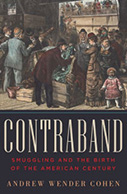Contraband: Smuggling And The Birth Of The American Century

Author: Andrew Wender Cohen
Publisher: New York: W.W. Norton & Company, 2015. 402p.
Reviewer: Christopher P. Magra | March 2017
Current concern over who and what legally enters the United States has stimulated a lot of interest in the history of smuggling. Recent studies have focused on individual aspects of smuggling such as arguments for free trade, the power and reach of governments, and political identities. Andrew Wender Cohen’s wonderful new book weaves together these various threads to explain the relationship between changing attitudes toward contraband and the rise of the American Century.
Cohen has an exceptional ability to reach academic and non-academic audiences. Contraband is the best example of a crossover book. Cohen brilliantly tells the stories of particular smugglers. These dramatic narratives are engaging and pages will turn seemingly of their own accord. But, there is a point to each account. These are not just ripping good yarns. Cohen convincingly links smugglers’ lives to larger themes in U.S. history.
Contraband covers a lot of ground. The story begins in the American Revolution, when patriots such as John Hancock were smugglers. Alexander Hamilton played an important role as Secretary of the Treasury Department in changing American attitudes toward illicit commerce. He advocated for protective tariffs, hired more customs agents, and managed the Revenue Marine Service, which hunted tariff violators. As a result of his efforts, Northern manufacturers came to see “smuggling as treason in miniature, a threat to domestic industry, and a challenge to American identity” (20). Southern slaveholders, however, still held onto the notion that smuggling was a patriotic defense of free trade. Attitudes toward illicit commerce became a political litmus test and deepened the sectional divide in this country over the course of the early 1800s. Readers well-versed in the origins of the Civil War will learn how smugglers like Jean Lafitte deepened the tensions surrounding such famous events as the Nullification Crisis. Smuggling proved to be a powerful cultural talisman that helped Americans think and talk about state’s rights and the power of the federal government. During the Civil War, the Union navy blockaded the coastline while Northern Republicans pushed for additional protective tariffs. During Reconstruction, smuggling became associated with the Confederacy and disloyalty. Supporting tariffs and commercial regulations, by contrast, defended American jobs from foreign competition. Touting tariffs then gave way to promoting prohibitions at the beginning of the twentieth century. These prohibitions, in turn, led to new forms of smuggling in the twentieth century.
Cohen covers so much ground that at times he is forced to paint over complexities with a broad brush. For most of the book, the North is presented as distinct from the South. The former is for greater federal control over commerce, while the later stands for free trade. This binary is tough to square with the portraits of Northern smugglers that continue to appear in the book. Rather than contributing to a sectional divide that persisted well after the Civil War, it is possible that debates over smuggling added to a larger, deeper ideological rift in this country over the role of the federal government in economic development. Despite this caveat, anyone interested in the history of illicit behavior and law enforcement will find much of interest in Cohen’s gripping account of changing American attitudes toward smuggling.
Dr. Christopher P. Magra, The University of Tennessee


